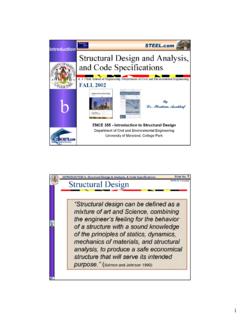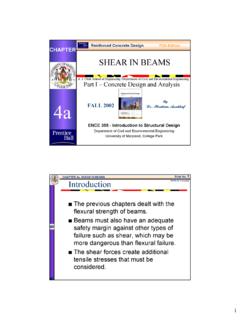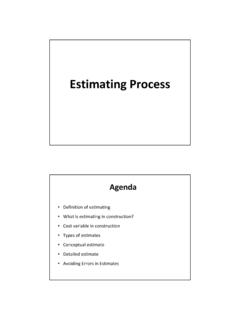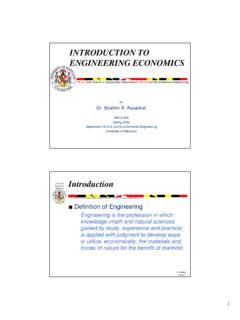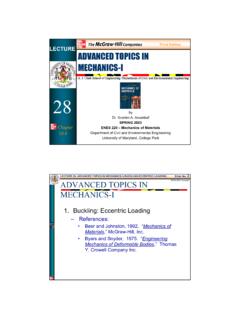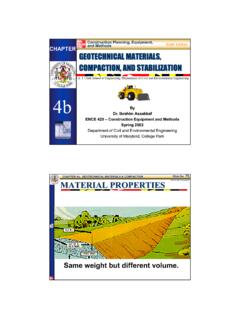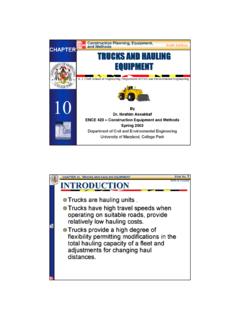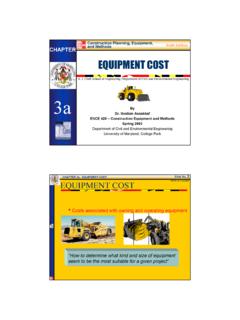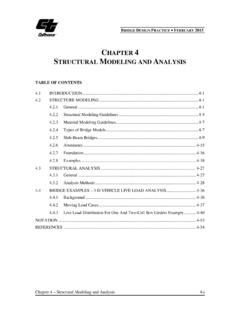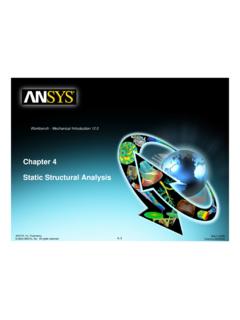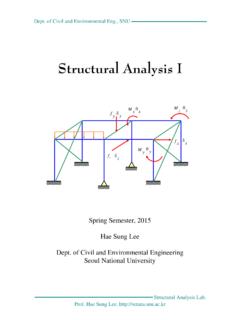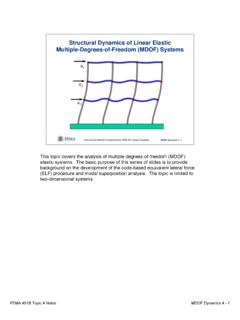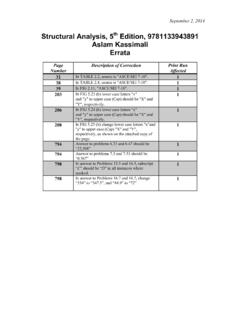Transcription of CHAPTER STRUCTURAL ANALYSIS - assakkaf
1 1 College of Engineering Department of Mechanical EngineeringTenth EditionCHAPTER6aEngineering Mechanics: StaticsSTRUCTURAL ANALYSISbyDr. Ibrahim A. AssakkafSPRING 2007 ENES 110 StaticsDepartment of Mechanical EngineeringUniversity of Maryland, Baltimore CountySlide No. 1 CHAPTER 6a. STRUCTURAL ANALYSISENES110 Assakkaf_SP07 Trusses Methods of JointsLecture s Objectives:Students will be able to:a) Define a simple ) Determine the forces in members of a simple ) Identify zero-force Activities: Reading quiz Applications Simple truss Methods of joints Zero-force members Concept quiz Group problem solving Attention quiz2 Slide No. 2 CHAPTER 6a. STRUCTURAL ANALYSISENES110 Assakkaf_SP07 Reading Quiz1. One of the assumptions used when analyzing a simple truss is that the members are joined together by ) weldingB) boltingC) rivetingD) smooth pinsE) super glue2.
2 In the method of joints, typically _____ equations of equilibrium are applied at every ) twoB) threeC) fourD) sixSlide No. 3 CHAPTER 6a. STRUCTURAL ANALYSISENES110 Assakkaf_SP07 ApplicationsTrusses are commonly used to support a a given truss geometry and load, how can we determine the forces in the truss members and select their sizes?A more challenging question is that for a given load, how can we design the trusses geometry to minimize cost?3 Slide No. 4 CHAPTER 6a. STRUCTURAL ANALYSISENES110 Assakkaf_SP07 Applications (cont d)Trusses are also used in a variety of structures like cranes and the frames of aircraft or space can we design a light weight structure that will meet load, safety, and cost specifications?Slide No. 5 CHAPTER 6a. STRUCTURAL ANALYSISENES110 Assakkaf_SP07 Defining a Simple Truss (Section )A trussis a structure composed of slender members joined together at their end a truss, along with the imposed load, lies in a single plane (as shown at the top right), then it is called a planar simple trussis a planar truss which begins with a a triangular element and can be expanded by adding two members and a joint.
3 For these trusses, the number of members (M) and the number of joints (J) are related by the equationM= 2 J No. 6 CHAPTER 6a. STRUCTURAL ANALYSISENES110 Assakkaf_SP07 ANALYSIS and Design AssumptionsWhen designingboth the member and the joints of a truss, first it is necessary to determine the forces in each truss member. This is called the forceanalysisof a truss. When doing this, two assumptions are made:1. All loads are applied at the joints. The weight of the truss members is often neglected as the weight is usually small as compared to the forces supported by the The members are joined together by smooth pins. This assumption is satisfied in most practical cases where the jointsare formed by bolting or these two assumptions, the members act as two-force members. They are loaded in eithertension or compression. Often compressive members are made thicker to prevent No.
4 7 CHAPTER 6a. STRUCTURAL ANALYSISENES110 Assakkaf_SP07 The Method of Joints (Section )In this method of solving for the forces in truss members, the equilibrium of a joint (pin)is considered. All forces acting at the joint are shown in a FBD. This includes all external forces (including support reactions) as well as the forces acting in the members. Equations of equilibrium ( Fx= 0 and Fy= 0) are used to solve for the unknown forces acting at the No. 8 CHAPTER 6a. STRUCTURAL ANALYSISENES110 Assakkaf_SP07 Steps for Analysis1. If the support reactions are not given, draw a FBD of the entire truss and determine all the support reactions using the equations of Draw the free-body diagram of a joint with one or two unknowns. Assume that all unknown member forces act in tension (pulling the pin)unless you can determine by inspection that the forces are compression Apply the scalar equations of equilibrium, Fx= 0 and Fy= 0, to determine the unknown(s).
5 If the answer is positive, then the assumed direction (tension)is correct, otherwise it is in the opposite direction (compression).4. Repeat steps 2 and 3 at each joint in succession until all the required forces are No. 9 CHAPTER 6a. STRUCTURAL ANALYSISENES110 Assakkaf_SP07 Example 1 Given:P1= 200 lb, P2= 500 lbFind:The forces in each member of the :First analyze pin Band then pin C+ Fx= 500 + FBCcos 45 (3 / 5) FBA= 0+ Fy= 200 FBCsin 45 (4 / 5) FBA= 0 FBA= 214 lb (T)and FBC= lb (C)+ Fx= FCA+ cos 45 = 0 FCA= 371 (T) FBD of pin C45 FBC200 lbB500 lbFBAFBD of pin B5 436 Slide No. 10 CHAPTER 6a. STRUCTURAL ANALYSISENES110 Assakkaf_SP07 Zero-Force Members (Section )If a joint has only two non-collinear members and there is no external load or support reaction at that joint, then those two members are zero-force members.
6 In this example members DE, CD, AF, and ABare zero force can easily prove these results by applying the equations of equilibrium to joints Dand members can be removed (as shown in the figure) when analyzingthe No. 11 CHAPTER 6a. STRUCTURAL ANALYSISENES110 Assakkaf_SP07 Zero-Force Members (cont d)If three members form a truss joint for which two of the members are collinear and there is no external load or reaction at that joint, then the third non-collinear member is a zero force , this can easily be proven. One can also remove the zero-force member, as shown, on the left, for analyzingthe truss note that zero-force members are used to increase stability and rigidity of the truss, and to provide support for various different loading No. 12 CHAPTER 6a. STRUCTURAL ANALYSISENES110 Assakkaf_SP07 Concept Quiz1. Truss ABCis changed by decreasing its height from hto h.
7 Width wand load Pare kept the same. Which one of the following statements is true for the revised truss as compared to the original truss?A) Force in all its members have ) Force in all its members have ) Force in all its members have remained the ) None of the No. 13 CHAPTER 6a. STRUCTURAL ANALYSISENES110 Assakkaf_SP07 Concept Quiz (cont d)2. For this truss, determine the number of zero-force ) 0B) 1C) 2D) 3E) 4 FFF8 Slide No. 14 CHAPTER 6a. STRUCTURAL ANALYSISENES110 Assakkaf_SP07 Example 2 Given:P1= 240 lb and P2= 100 lbFind:Determine the force in all the truss members (do not forget to mention whether they are in Tor C).Plan:a) Check if there are any zero-force ) Draw FBDs of pins Dand B, and then apply EofE at those pins to solve for the :Members ABand ACare zero-force No. 15 CHAPTER 6a. STRUCTURAL ANALYSISENES110 Assakkaf_SP07 Example 2 (cont d)Analyzing pin D: + Fy= 100 (5 / 13) FDB= 0 FDB= 260 lb (C) + Fx= 240 FDC (12 / 13) ( 260) = 0 FDC= 480 lb (T)Analyzing pin B: + Fy= FBC (5 / 13) 260 = 0 FBC = 100 lb (T)FDByDFDC240 lbx13 512100 lbFBD of pin DFBCy260 lbBx13 512 BxFBD of pin B9 Slide No.
8 16 CHAPTER 6a. STRUCTURAL ANALYSISENES110 Assakkaf_SP07 Attention Quiz1. Using this FBD, you find that FBC= 500 BCmust be in ) tension B) compressionC) Can not be determined2. For the same magnitude of force to be carried, truss members in compression are generally made _____ as compared to members in ) thickerB) thinnerC) the same sizeFBDFBCBBy
